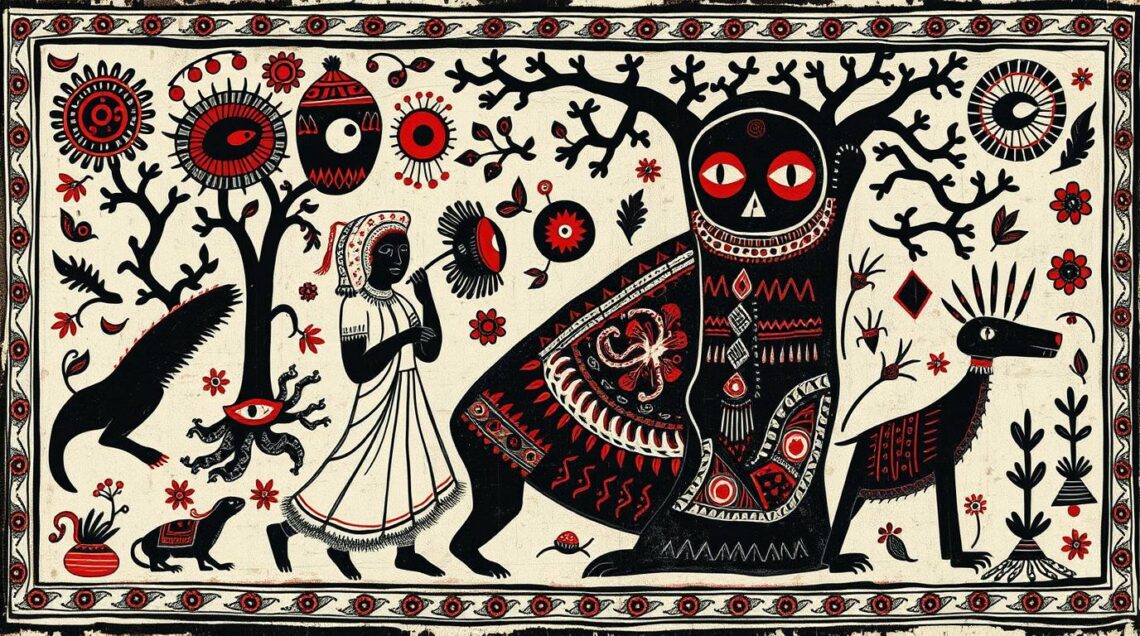
Baiga Art Painting: Bringing Tribal Folk Art to Contemporary Spaces
India’s tribal communities have always been a source of vibrant creativity, producing art forms that reflect their intimate connection with nature, spirituality, and daily life. Among these, Baiga Art Painting stands out as a striking expression of the Baiga tribe’s cultural and artistic heritage. Known for its intricate geometric patterns, earthy tones, and symbolic storytelling, Baiga art has traditionally been practiced within the tribal communities of Madhya Pradesh and Chhattisgarh.
The uniqueness of Baiga handmade art painting lies in its ability to convey complex narratives of tribal life using simple materials and natural pigments. Artists like Jodhaiya Bai have played an instrumental role in bringing Baiga art from village homes and ritual spaces into galleries, contemporary homes, and international platforms, preserving its authenticity while making it relevant to modern audiences.
Historical Roots of Baiga Art
Baiga art is deeply rooted in the lifestyle and traditions of the Baiga tribe, one of the oldest indigenous communities in central India. Traditionally, the Baigas were forest dwellers, and their art reflects a profound connection with the environment, wildlife, and seasonal cycles. Historically, Baiga paintings were created on walls, floors, and sometimes cloth during festivals, rituals, and significant life events such as births, marriages, and harvests.
Unlike art forms created primarily for aesthetics or commerce, Baiga art functioned as a cultural narrative, documenting tribal knowledge, spiritual beliefs, and social practices. Each painting, through its motifs and patterns, served as a record of community life, blending symbolism, ritual, and artistic expression seamlessly.
Techniques and Materials in Baiga Handmade Art Painting
The techniques employed in Baiga handmade art painting distinguish it from other tribal and folk art traditions. Natural pigments derived from soil, charcoal, leaves, and minerals provide earthy reds, browns, blacks, and whites, giving the art its distinctive tone and texture. Traditional brushes are often crafted from twigs, bamboo sticks, or even fingers, enabling artists to achieve precise detailing in their geometric designs.
One notable feature of Baiga paintings is the use of repetitive geometric patterns that create a sense of rhythm and harmony. Triangles, circles, and lines are carefully arranged to represent animals, human figures, trees, and sacred symbols. Each element is placed deliberately, often reflecting mythological narratives or ritualistic symbolism.
Modern adaptations now allow Baiga artists to paint on paper, canvas, textiles, and other contemporary mediums, expanding the reach of this traditional art form while retaining its handmade integrity and cultural significance.
Symbolism and Themes
Symbolism is at the heart of Baiga art. Animals such as tigers, elephants, and birds symbolize strength, freedom, and the tribe’s deep reverence for nature. Human figures are often depicted engaging in communal activities like farming, hunting, and ritual dancing, emphasizing the interdependence of humans and their environment.
Celestial symbols, including the sun, moon, and stars, often appear in Baiga paintings, reflecting the tribe’s spiritual worldview and cosmic awareness. Geometric motifs not only serve a decorative function but also represent mountains, rivers, forests, and other natural or sacred spaces, creating a layered narrative that blends mythology, daily life, and environmental harmony.
This symbolic richness is what sets Baiga art apart, making each painting a visual story that connects the viewer to the cultural ethos of the tribe.
The Role of Artists in Preserving Baiga Art
Artists like Jodhaiya Bai are crucial in preserving and promoting Baiga art. Through exhibitions, workshops, and collaborations, they have introduced this tribal art form to broader audiences, ensuring its recognition at national and international levels. By teaching traditional techniques and explaining the cultural and symbolic significance of each motif, these artists are training a new generation to continue the legacy of Baiga handmade art painting.
The efforts of such artists have also created economic opportunities for the Baiga community, helping sustain traditional practices in a rapidly modernizing world. Their work ensures that Baiga art remains a living tradition rather than a static historical artifact.
Bringing Baiga Art into Contemporary Spaces
One of the most exciting developments in Baiga art is its adaptation to contemporary settings. While traditionally confined to village homes and ritual contexts, Baiga paintings now adorn galleries, modern interiors, fashion textiles, and lifestyle products. Their geometric patterns, earthy color palette, and narrative depth make them highly versatile for contemporary design applications.
Interior designers use Baiga motifs in murals, wall hangings, and furniture embellishments, bringing a sense of tribal authenticity and storytelling into modern living spaces. Fashion designers incorporate these patterns into clothing and accessories, blending traditional artistry with contemporary style. Digital media platforms and online galleries have further amplified the reach of Baiga art, introducing it to a global audience that appreciates its handmade uniqueness and cultural depth.
Challenges in Modernization
Despite its growing popularity, Baiga art faces challenges. Commercialization can sometimes dilute its authenticity, leading to imitation products that do not respect traditional techniques or symbolism. Limited documentation and exposure of the art form also pose a risk to its preservation.
Addressing these challenges requires a balance between innovation and tradition. Artists like Jodhaiya Bai are instrumental in this process, ensuring that the art remains true to its roots while exploring modern applications. Workshops, exhibitions, and educational initiatives help maintain the cultural context, teaching learners about the significance of motifs, colors, and storytelling in Baiga art.
Cultural Significance and Legacy
Baiga art is more than a visual delight—it is a cultural record. Each painting embodies the tribe’s beliefs, social structures, and ecological knowledge, making it a repository of intangible heritage. The art preserves the connection between humans and nature, reflecting rituals, spiritual practices, and communal values.
The handmade quality of Baiga paintings also emphasizes personal involvement and dedication. Every stroke carries intention, patience, and cultural meaning. In an era of mass production, this authenticity gives Baiga art a timeless and universal appeal.
Why Baiga Art Painting Is Unique
Baiga art stands out among Indian tribal and folk arts due to its earthy aesthetic, geometric precision, and narrative depth. Unlike other decorative art forms, Baiga paintings communicate a story, a belief system, and an understanding of nature’s rhythms. The art’s ability to be both ritualistic and adaptable to modern contexts enhances its uniqueness.
Its handmade character, reliance on natural materials, and symbolic richness make Baiga paintings valuable not only as artistic creations but also as cultural artifacts. Contemporary artists and collectors increasingly recognize this dual significance, appreciating Baiga art for its aesthetic charm and its role in preserving tribal identity.
Conclusion
Baiga Art Painting is a living testament to the creativity, spirituality, and heritage of India’s tribal communities. Its geometric patterns, earthy tones, and symbolic storytelling distinguish it as a unique and culturally significant art form. Through the efforts of artists like Jodhaiya Bai, Baiga art has successfully transitioned from tribal homes and ritual spaces to contemporary galleries, interiors, and global platforms, without losing its authenticity.By embracing Baiga handmade art painting, we honor centuries of tradition, ecological awareness, and cultural expression. Bringing this tribal folk art into contemporary spaces ensures its preservation, appreciation, and continued evolution, allowing Baiga art to inspire and captivate audiences for generations to come.
You May Also Like

NFT Gaming: The Next Big Thing in Metaverse
August 2,
How Can Website Development Services Help You Achieve Your Goals?
August 7,


